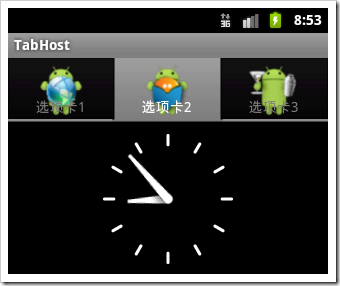android 之 TabHost
TabHost的實現有兩種方式,第一種繼承TabActivity,從TabActivity中用getTabHost()方法獲取TabHost。各個Tab中的內容在布局文件中定義就行了。
mainActivity.xml
private TabHost myTabHost;
@Override
public void onCreate(Bundle savedInstanceState) {
super.onCreate(savedInstanceState);
//setContentView(R.layout.main);
myTabHost = this.getTabHost();LayoutInflater.from(this).inflate(R.layout.main,
myTabHost.getTabContentView(), true);
myTabHost.addTab(myTabHost
.newTabSpec("選項卡1")
.setIndicator("選項卡1",
getResources().getDrawable(R.drawable.img01))
.setContent(R.id.ll01));
myTabHost.addTab(myTabHost
.newTabSpec("選項卡2")
.setIndicator("選項卡2",
getResources().getDrawable(R.drawable.img02))
.setContent(R.id.ll01));
myTabHost.addTab(myTabHost
.newTabSpec("選項卡3")
.setIndicator("選項卡3",
getResources().getDrawable(R.drawable.img03))
.setContent(R.id.ll03));}
Tab內容布局文件:
<?xml version="1.0" encoding="utf-8"?>
<FrameLayout xmlns:android="http://schemas.android.com/apk/res/android"
android:orientation="vertical" android:layout_width="fill_parent"
android:layout_height="fill_parent">
<LinearLayout android:id="@+id/ll01" android:layout_width="fill_parent"
android:layout_height="fill_parent" android:gravity="center_horizontal"
android:orientation="vertical">
<EditText android:id="@+id/widget34" android:layout_width="fill_parent"
android:layout_height="wrap_content" android:text="EditText"
android:textSize="18sp">
</EditText>
<Button android:id="@+id/widget30" android:layout_width="wrap_content"
android:layout_height="wrap_content" android:text="Button">
</Button></LinearLayout>
<LinearLayout android:id="@+id/ll02" android:layout_width="fill_parent"
android:layout_height="fill_parent" android:gravity="center_horizontal"
android:orientation="vertical">
<AnalogClock android:id="@+id/widget36"
android:layout_width="wrap_content" android:layout_height="wrap_content">
</AnalogClock>
</LinearLayout>
<LinearLayout android:id="@+id/ll03" android:layout_width="fill_parent"
android:layout_height="fill_parent" android:gravity="center_horizontal"
android:orientation="vertical">
<RadioGroup android:id="@+id/widget43"
android:layout_width="166px" android:layout_height="98px"
android:orientation="vertical">
<RadioButton android:id="@+id/widget44"
android:layout_width="wrap_content" android:layout_height="wrap_content"
android:text="RadioButton">
</RadioButton>
<RadioButton android:id="@+id/widget45"
android:layout_width="wrap_content" android:layout_height="wrap_content"
android:text="RadioButton">
</RadioButton>
</RadioGroup></LinearLayout>
</FrameLayout>

第二種方式,不繼承TabActivity,在布局文件中定義TabHost即可,[email protected]:id/tabs,[email protected]:id/tabcontent。
<?xml version="1.0" encoding="utf-8"?>
<LinearLayout xmlns:android="http://schemas.android.com/apk/res/android"
android:id="@+id/hometabs"
android:orientation="vertical"
android:layout_width="fill_parent"
android:layout_height="fill_parent">
<TabHost android:id="@+id/tabhost"
android:layout_width="fill_parent"
android:layout_height="wrap_content">
<LinearLayout
android:orientation="vertical"
android:layout_width="fill_parent"
android:layout_height="fill_parent">
<TabWidget android:id="@android:id/tabs"
android:orientation="horizontal"
android:layout_width="fill_parent"
android:layout_height="wrap_content">
</TabWidget>
<FrameLayout android:id="@android:id/tabcontent"
android:layout_width="wrap_content"
android:layout_height="wrap_content">
<TextView android:id="@+id/view1"
android:layout_width="fill_parent"
android:layout_height="fill_parent" android:text="Tab1"/>
<TextView android:id="@+id/view2"
android:layout_width="fill_parent"
android:layout_height="fill_parent" android:text="Tab2"/>
<TextView android:id="@+id/view3"
android:layout_width="fill_parent"
android:layout_height="fill_parent" android:text="Tab3"/>
</FrameLayout>
</LinearLayout>
</TabHost>
</LinearLayout>
mainActivity
@Override
protected void onCreate(Bundle savedInstanceState) {
super.onCreate(savedInstanceState);
setContentView(R.layout.main);TabHost tabHost = (TabHost) findViewById(R.id.tabhost);
tabHost.setup();
TabWidget tabWidget = tabHost.getTabWidget();tabHost.addTab(tabHost
.newTabSpec("tab1")
.setIndicator("tab1",
getResources().getDrawable(R.drawable.img01))
.setContent(R.id.view1));tabHost.addTab(tabHost
.newTabSpec("tab2")
.setIndicator("tab2",
getResources().getDrawable(R.drawable.img02))
.setContent(R.id.view2));tabHost.addTab(tabHost
.newTabSpec("tab3")
.setIndicator("tab3",
getResources().getDrawable(R.drawable.img03))
.setContent(R.id.view3));
android 之 TabHost
